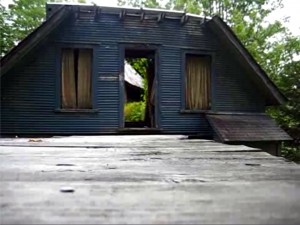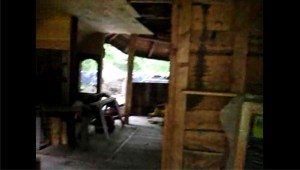Nina practiced “the art of dying.” She had started dying many years before I met her, even if her body didn’t manage it until 2002. She saw it as Alan Watts did: “Dying is an art. It’s also an adventure.”
One example was that, during the time I knew her, she began dismantling her house.
Each time I visited, less and less of it remained. It was a small Vermont farmhouse, surrounded by trees because the forest had grown up in the 150 years since it had been built. It was cold and drafty at best, yet Nina had begun removing the outer walls, leaving the rooms open to the outdoors in all seasons. Where necessary, she stacked bales of hay to hold up the roof. She stripped the interior walls of their lath and plaster to reveal the raw boards inside.
You can get a rough sense of it from a video at https://myspace.com/180683135/videos. I have not been there in 25 years, but the shingled, curved roof on the exterior front of the house is a relatively recent addition; the interior is the old farmhouse, its inner walls stripped, outer walls opened to the encroaching forest.
She was dismantling her physical existence.
Such activities could be seen as the work of a highly eccentric, perhaps unbalanced person. But no one who knew Nina — the clarity and poetry of her speech, her poised physical presence, the perfectly-articulated logic of her metaphysical discourse — could consider her anything but supremely balanced.
Similarly, my preceding posts make Nina sound like a crabby and intolerant person. But she wasn’t, and our visits spanned many moods.
She could laugh like no one else. For example, there was a period when several young people came to me seeking to learn shamanistic practices. I was egocentric enough to encourage them — and, in fact, the magical gift did sometimes come to us during our woods walks; we sometimes experienced truly rare and miraculous events. In any case, I brought one young man, a student at Goddard College, to see Nina as part of his magical education.
B.L. was very young — intelligent, cheerful, clumsy, open-faced, naive. His nose always seemed to be running, and despite my efforts to teach him to walk in balance and silence, he’d stumble around, even in winter, trailing his untied shoe laces behind him. His curiosity and open-mindedness commended him even if his aptitude did not.
When I explained the purpose of our visit, sitting on the floor across from Nina, she inspected him briefly and then exploded with laughter. I did too. It was gut-clenchingly funny, and she almost fell over; I think I actually did. I saw the scene through her eyes: here’s this completely undisciplined, clownish kid aspiring to become a shaman. And, talk about the blind leading the blind, here’s Daniel, a completely undisciplined clownish kid with the hubris to play teacher!
It was hilarious, an absolute hoot. We absolutely cracked up. Poor B.L. didn’t know what came over us.
Another visit: For several years, I carried with me a special black stone that I had found in the surf at Big Sur. It was an irregularly roundish, smooth black stone about the size of a half-dollar, about a quarter inch thick, and over the years I’d rubbed it with my thumb and oiled it on my nose until it had a satiny glow. More than a good-luck charm, it was for me a kind of psychic battery, a repository for energy that I imparted to it over time and that I could, when needed, draw energy from.
At some point, after coming back from another California trip, I decided it had served me long enough and that I’d give it to Nina. As always, I sat across from her on the floor in the band of light from the window. She was cheerful and glad to see me. I told her I had a present for her and handed her the stone.
Her face lit up when she saw it. “I have a place just for it!” she exclaimed.
Since I’d last visited her, she had been making a mosaic on her floor, imbedding many small stones and tiles in cement. She laid my stone into a gap in the design — where it fit perfectly. She was radiantly happy at the gift: at the magic that had made her leave that one space open, that had led me to find just that stone at Big Sur all those years before, and to present it to her at just that moment.
One final, crucial memory: I had always been repelled by the way her followers treated her — such deference, such hushed self-effacement, such an exalted, perverted perspective on Nina’s physical self. Once, when Nina had badly cut her ankle, one of her acolytes explained to me that it wasn’t really a physical injury, but a psychic one — a spiritual injury, something I wouldn’t really understand.
“Hey,” I told her, “all damned injuries to anyone are spiritual injuries.” I had recently wrecked my knees during some free-running acrobatics, and the absence of my usual mobility was a genuine, painful impediment to my way of living, to my practice. “Trust me, a man who breaks his leg and can’t go to work to earn money to feed his kids — that’s a spiritual injury, too!” I told her. “Everyone’s body is an avatar. Your idea that there’s a spiritual hierarchy, with higher and lower beings, is self-serving bullshit.”
I was furious with Nina’s followers for what I saw as their dehumanizing treatment of her. They could not construe anything she did or that befell her as simply a part of a human woman’s life experience. It was always something “beyond,” “more important” than the “mere” human experience. In this, and in their failure to challenge her egotism — demonstrated by her outrage at my introductory somersault — I felt they robbed her of experiences that would allow her to grow into her full personhood.
This I refused to do, and I believe Nina appreciated my refusal.
Once, during one of our walks in the woods behind the house, the two of us wandered for a bit and then hesitated at a fork in the path.
“Look,” I said. “Two paths!” She knew what I meant: There is no single way, there is no need for all to take one path. They all wander through the beautiful woods.
She gazed at me and rather sadly said — I wish I could remember her exact words! — “I am so glad you are here to remind me what I really am. Too few of the people around me have the courage.”
Then she took one path, and I, determined to always challenge her, took the other. Of course, as paths will, the two strands reunited only a few yards farther on.



